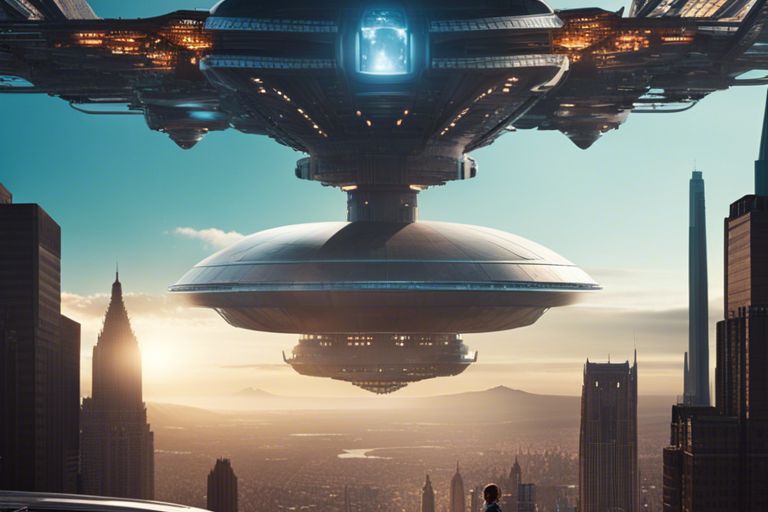Prepare to immerse yourself in the cinematic wonders of these groundbreaking sci-fi films that have redefined the limits of imagination and storytelling. From mind-bending concepts to visually stunning landscapes, these movies have taken audiences on unforgettable journeys through the realms of science fiction. Whether it’s through visionary filmmakers, innovative special effects, or thought-provoking narratives, these films have left an indelible mark on the genre and continue to inspire new generations of filmmakers and storytellers. So, grab your popcorn and buckle up as we count down the top 10 sci-fi movies that have truly pushed the boundaries of imagination.
“2001: A Space Odyssey”
Before “2001: A Space Odyssey”, the concept of science fiction in cinema was largely limited to B-movies and pulp adventures. Director Stanley Kubrick changed the game with his 1968 masterpiece, a visually stunning and thought-provoking exploration of human evolution, artificial intelligence, and our place in the universe.
Visual storytelling
One of the most striking aspects of “2001: A Space Odyssey” is its groundbreaking use of visual storytelling. Kubrick utilized innovative special effects and meticulously crafted sets to create a sense of otherworldly grandeur. From the breathtaking opening sequence featuring the dawn of man to the iconic monolith floating in space, the film’s visuals captivate audiences and set a new standard for cinematic imagination.
In addition to its stunning visuals, “2001: A Space Odyssey” is renowned for its attention to philosophical depth. Kubrick and co-writer Arthur C. Clarke infused the narrative with complex themes of technology, consciousness, and the nature of humanity. The film’s enigmatic nature invites audiences to ponder the deeper meanings behind its mesmerizing imagery, sparking discussions and interpretations that continue to fascinate viewers to this day.
Philosophical depth
To further enhance the philosophical depth of “2001: A Space Odyssey,” Kubrick and Clarke deliberately left many elements of the story open to interpretation. This deliberate ambiguity allows the film to transcend mere entertainment, encouraging viewers to contemplate profound questions about the nature of existence, the potential of artificial intelligence, and the mysteries of our universe. “2001: A Space Odyssey” invites audiences to ponder the unknown, embracing the enigmatic and thought-provoking nature of true science fiction.
“Blade Runner”
Some sci-fi movies are not just cinematic experiences; they are visual and philosophical mind-benders that push the boundaries of imagination. “Blade Runner” is one such film that has left a lasting impact on the genre and continues to be a source of inspiration for filmmakers and audiences alike.
Cyberpunk aesthetics
For “Blade Runner,” director Ridley Scott created a world that was dark, gritty, and technologically advanced – a vision of the future that was both awe-inspiring and unsettling. The film’s cyberpunk aesthetics, with its neon-lit cityscapes, towering skyscrapers, and rain-soaked streets, became a defining element of the genre. It presented a future that was at once familiar and alien, blurring the lines between human and artificial, organic and synthetic.
To delve into the cyberpunk themes of “Blade Runner” is to delve into a world where the boundaries between humanity and technology are blurred, where ethical dilemmas arise from the creation of artificial beings and the implications of playing god. The film’s exploration of these complex issues has had a profound influence on the way we contemplate the ethical implications of advancing technology, artificial intelligence, and the nature of consciousness.

“Matrix”
The “Matrix” is a groundbreaking sci-fi movie that pushed the boundaries of imagination and revolutionized the genre. Directed by the Wachowskis, this 1999 film took the world by storm with its mind-bending storyline, cutting-edge special effects, and thought-provoking themes.
Virtual reality
To begin with, “Matrix” introduced the concept of virtual reality in a way that had never been seen before. The film depicted a dystopian future where humans were unknowingly trapped in a simulated reality created by intelligent machines. This idea of a simulated world, where individuals are essentially living in a computer-generated environment, opened up a whole new realm of possibilities for exploring the impact of technology on humanity.
On top of that, “Matrix” delved into the philosophical implications of living in a virtual world, raising profound questions about the nature of reality, free will, and control. The movie challenged audiences to ponder the very fabric of their existence and contemplate the blurred lines between what is real and what is artificial, leaving a lasting impression on the sci-fi genre and popular culture as a whole.
“Inception”
Keep your mind open, because Christopher Nolan’s “Inception” will take you on a mind-bending journey through the depths of the subconscious. This 2010 masterpiece is a testament to Nolan’s visionary storytelling and unparalleled dedication to pushing the boundaries of imagination in cinema.
Dream manipulation
For those unfamiliar with the concept of dream manipulation, “Inception” introduces a compelling narrative centered around the ability to enter and manipulate dreams. The film delves into the intricate layers of the human mind, exploring the possibility of planting ideas and extracting information from the subconscious. With stunning visual effects and a gripping plot, “Inception” challenges the conventional notions of reality and offers a mesmerizing portrayal of dream exploration.
Complex narrative
The complexity of “Inception” lies not only in its exploration of dream manipulation, but also in the intricate layers of the narrative itself. The film seamlessly weaves together multiple timelines and realities, blurring the lines between dreams and reality. As the characters navigate through different levels of consciousness, the audience is taken on a riveting journey that challenges their perception of what is real and what is a construct of the mind.
Dreams within dreams, time dilation, and the manipulation of memories are just some of the elements that contribute to the intricate and multi-faceted narrative of “Inception”. This complexity sets the film apart as a true masterpiece of science fiction storytelling, pushing the boundaries of imagination and leaving a lasting impression on audiences worldwide.
“Interstellar”
Your journey into the unexplored realms of space and time begins with “Interstellar”, a groundbreaking sci-fi movie that challenges the limits of human imagination. Directed by Christopher Nolan, this epic film takes viewers on an exhilarating adventure through the cosmos, weaving together complex themes of love, sacrifice, and the relentless pursuit of knowledge.
Time dilation
Interstellar delves into the mind-bending concept of time dilation, where the passage of time varies between different regions of space. As the crew of astronauts embarks on a daring mission to find a new habitable planet for humanity, they encounter the mind-boggling effects of time dilation firsthand. This phenomenon leads to gripping scenes where the characters grapple with the emotional toll of being separated by vast expanses of time, highlighting the profound implications of relativity on their journey.
Black hole travel
With its groundbreaking portrayal of black hole travel, “Interstellar” offers a mesmerizing depiction of the enigmatic cosmic entities. The film presents a visually stunning representation of a black hole, capturing its awe-inspiring gravitational pull and warping of spacetime. The crew’s harrowing descent into the black hole showcases the stunning visual effects that earned the movie critical acclaim, immersing audiences in the raw power and mystery of these cosmic phenomena.
The breathtaking portrayal of black hole travel in “Interstellar” not only captivated audiences with its visual splendor, but also ignited widespread discussions among scientists and enthusiasts about the accuracy of its representation. The meticulous attention to scientific detail and the collaboration with renowned physicist Kip Thorne lent a sense of authenticity to the film’s portrayal of black holes, cementing its status as a trailblazing sci-fi masterpiece.
“Arrival”
Unlike many other sci-fi movies that focus on action and special effects, “Arrival” delves into the complexities of language, time, and communication with extraterrestrial beings. Directed by Denis Villeneuve and based on the short story “Story of Your Life” by Ted Chiang, this thought-provoking film challenges the traditional notions of alien encounters and explores the profound impact of linguistic and temporal understanding.
Language and time
To truly grasp the essence of “Arrival,” one must appreciate the film’s unique portrayal of language and time. The Arrival tells the story of a linguistics expert, Dr. Louise Banks, who is tasked with deciphering the complex language of the alien visitors. As she delves deeper into their enigmatic communication, she begins to unlock the key to understanding their non-linear perception of time. The film skillfully intertwines these two themes, demonstrating how language and temporal concepts are intricately linked, ultimately leading to a revelation that transcends the traditional confines of human understanding.
Alien communication
Language plays a pivotal role in “Arrival,” as it serves as the primary conduit for communication with the extraterrestrial visitors. The film presents a unique and nuanced take on alien communication, highlighting the challenges and rewards of bridging the gap between two vastly different forms of linguistic expression. Through the protagonist’s diligent efforts to decipher the alien language, viewers are presented with a captivating exploration of the complexities of interstellar communication and the transformative power of linguistic understanding.
With its captivating exploration of language, time, and alien communication, “Arrival” stands as a testament to the power of thought-provoking science fiction. The film’s masterful storytelling and intellectual depth offer a compelling meditation on the intricacies of human and extraterrestrial interaction, pushing the boundaries of imagination and challenging audiences to contemplate the mysteries of the universe.
“Eternal Sunshine of the Spotless Mind”
Not all science fiction movies are about outer space, aliens, or advanced technology. Some delve into the inner workings of the human mind, and “Eternal Sunshine of the Spotless Mind” is a prime example of this. Directed by Michel Gondry and written by Charlie Kaufman, this 2004 film is a poignant exploration of memory, love, and the boundaries of human experience.
Memory erasure
With its focus on memory erasure, “Eternal Sunshine of the Spotless Mind” pushes the boundaries of imagination by presenting a technology that allows people to selectively erase memories. The concept of being able to remove specific memories raises thought-provoking questions about the nature of identity, personal growth, and the ethical implications of such a technology.
Furthermore, the film challenges traditional notions of memory by blurring the lines between reality and imagination, creating a visually stunning and emotionally charged experience for the audience.
Love story
For a sci-fi movie, “Eternal Sunshine of the Spotless Mind” stands out for its heartfelt portrayal of a love story. At its core, the film is a deeply moving exploration of human relationships, resilience, and the enduring power of love. The unconventional narrative structure, combined with stellar performances from Jim Carrey and Kate Winslet, elevates the film beyond the confines of traditional genre expectations.
Sunshine aspect of the story shines through as the characters navigate the complexities of emotions and memories, resulting in a deeply affecting and thought-provoking cinematic experience. The film’s ability to blend science fiction with raw human emotions solidifies its place as a groundbreaking work in the genre, leaving a lasting impact on audiences and critics alike.
“Ex Machina”
After its release in 2014, “Ex Machina” quickly made a name for itself as a thought-provoking and visually stunning addition to the sci-fi genre. The film, directed by Alex Garland, tells the story of a young programmer who is selected to participate in a groundbreaking experiment in synthetic intelligence by evaluating the human qualities of a highly advanced humanoid robot named Ava. Filled with twists and turns, “Ex Machina” pushes the boundaries of imagination and challenges the audience to contemplate the nature of consciousness and the potential consequences of artificial intelligence.
AI humanity
The concept of artificial intelligence taking on human-like qualities is not a new one in the realm of sci-fi, but “Ex Machina” presents it in a fresh and intriguing way. The film delves into the idea of what it means to be human, as well as the ethical implications of bestowing human-like traits upon a machine. As the protagonist interacts with Ava, the lines between man and machine blur, leading to a captivating exploration of AI’s potential impact on humanity.
Ethical intrigue
With themes that delve deeply into the moral and ethical implications of creating artificial intelligence, “Ex Machina” raises questions about the responsibility that comes with advanced technological development. The film challenges the audience to consider the potential consequences of creating AI with human-like qualities, and the ethical dilemmas that arise from bestowing machines with the ability to think, feel, and act autonomously. To further complicate matters, the film introduces a web of ethical ambiguity, leaving the audience in a state of ethical introspection long after the credits roll.
“Annihilation”
Now, one of the most mind-bending and visually stunning sci-fi movies in recent years, “Annihilation” takes audiences on a journey through an otherworldly phenomenon known as The Shimmer. Directed by Alex Garland and based on Jeff VanderMeer’s novel, the film is a masterclass in pushing the boundaries of imagination and exploring the unknown.
Biological mutations
On the surface, “Annihilation” is a classic science fiction adventure, but it delves much deeper into the realm of biological mutations. The film presents a world where fundamental laws of nature are altered, giving birth to bizarre and terrifying mutations. The imagery of mutated creatures and plant life is both captivating and unsettling, challenging our perception of the natural world.
Psychological exploration
To complement its visual spectacle, “Annihilation” also incorporates a profound psychological exploration of the characters who venture into The Shimmer. As they confront the mysteries and terrors within, the film delves into themes of self-destruction, fear, and the unknown. It pushes the boundaries of the human mind, leaving audiences questioning the nature of reality and their own consciousness.
With its thought-provoking narrative and stunning visuals, “Annihilation” proves to be a captivating showcase of biological mutations and psychological exploration, solidifying its place as a boundary-pushing sci-fi masterpiece.
“The Fifth Element”
To sci-fi enthusiasts, “The Fifth Element” is a cult classic that has solidified its place in the genre’s hall of fame. Directed by Luc Besson and released in 1997, this film continues to captivate audiences with its futuristic visuals and eclectic storytelling. It pushed the boundaries of imagination and set a new standard for what sci-fi movies could achieve.
Futuristic visuals
One of the key highlights of “The Fifth Element” is its breathtaking futuristic visuals. From the bustling metropolis of New York City in the 23rd century to the dazzling spacecraft and alien landscapes, the film transports viewers to a visually stunning world that feels both futuristic and believable. The attention to detail and world-building in the film is unparalleled, creating an immersive experience that continues to inspire other sci-fi creators.
Eclectic storytelling
With an eclectic storytelling approach, “The Fifth Element” weaves together elements of action, adventure, comedy, and romance in a seamless manner. The film’s unique blend of genres and larger-than-life characters, such as the enigmatic Leeloo and the flamboyant Ruby Rhod, adds depth and unpredictability to the narrative. This results in a storyline that is both engaging and unconventional, leaving a lasting impact on audiences.
Futuristic technology, intergalactic travel, and larger-than-life characters are just a few of the elements that make “The Fifth Element” a standout in the sci-fi genre. It’s a film that continues to push the boundaries of imagination and remains a timeless classic for both longtime fans and newcomers to the genre.
To wrap up
The top 10 sci-fi movies that pushed the boundaries of imagination have truly set a new standard in the genre. From mind-bending visuals to thought-provoking storytelling, these movies have redefined what is possible in the realm of science fiction. They have not only entertained audiences but also inspired a new generation of filmmakers to push the boundaries even further. As we continue to explore the limits of our imagination, these movies will always stand as a testament to the power of creative storytelling and visual spectacle in the world of cinema.











Leave a Review